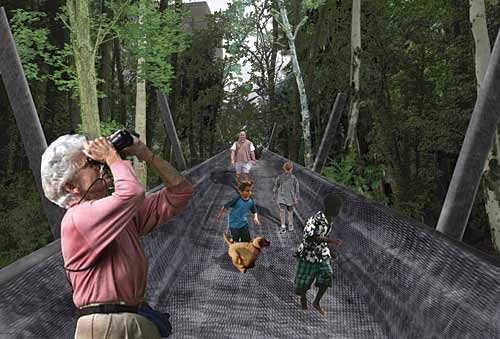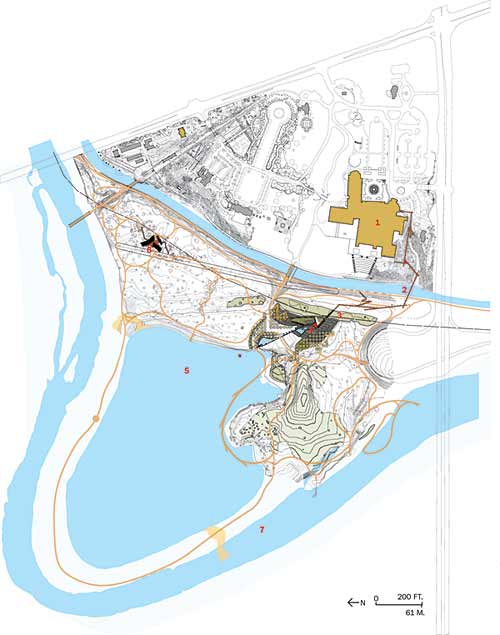Toward a Cybernetic Site
A path leading north from the Experiential Center follows rain gardens planned by Blake, skirting along a constructed wetland that will recycle all water used by that building and the next, which Blackwell calls the Interpretive Center. This gallery and classroom building, raised off the ground on pilotis, incorporates porous roofing and floor-decking systems to preserve groundwater recharge. "In some ways, the building is like a giant leaf," Blackwell says. In some circles, this would be considered biomimicry, or the adaptation of natural structure and performance to the built world. Miss, Blake, and Blackwell each practice a form of this, but shy away from using trendy terminology, including such seemingly innocuous words as sustainability. "I think of landscape as a building," Blake says. "I may put more water in or make it drier, or put pavement in to raise the temperature-all of those manipulations of nature-made materials are really human-made habitat."
|
Â
A growing body of literature supports the design approach epitomized by the Indianapolis project. Land and Natural Development (LAND) Code: Guidelines for Sustainable Land Development (John Wiley & Sons, 2007), written by landscape architect Diana Balmori and Gaboury Benoit [record, June 2007, page 186], explores site design strategies based on the latest scientific studies and technical resources available, rating various options to help designers understand what would contribute most to a project. For example, the book argues for a site imperviousness of less than 10 percent-plainly documenting the damage of higher imperviousness on watersheds. It then recommends solutions like rain gardens or green roofs.
Randolph T. Hester's thorough Design for Ecological Democracy (The MIT Press, 2006) artfully pleads for more of a total approach to city design based on a philosophy of community involvement and recognition of the interconnectedness of nature and urban infrastructure. Hester, a professor of landscape architecture at the University of California at Berkeley, is chiefly concerned with placemaking, long a design imperative of the landscape architect, but only rarely invoked in terms of sustainable design. As many architects will agree, sustainable design's value depends in large part on how much a client appreciates it. Hester's book calls to mind Ian L. McHarg's 1967 Design With Nature (Wiley, reissued 1992), which focuses primarily on placing cities within the larger contexts of regional watersheds and geological development. Clearly, the newer books are written to be used almost as tools, more pragmatic than McHarg's philosophical meditation on the big picture. Regardless, the literature all seeks to address what is perceived as the biggest challenge to the reclamation of site: rapid urbanization.











